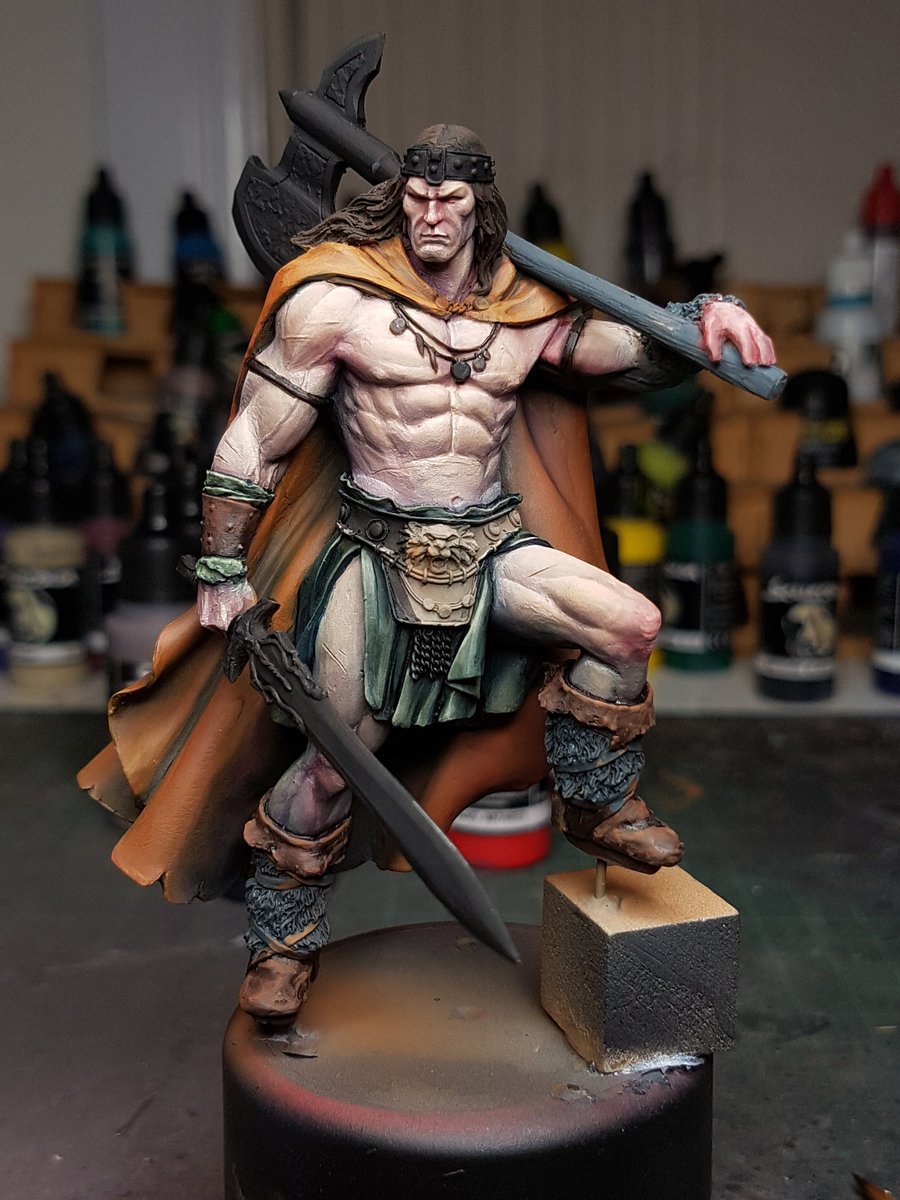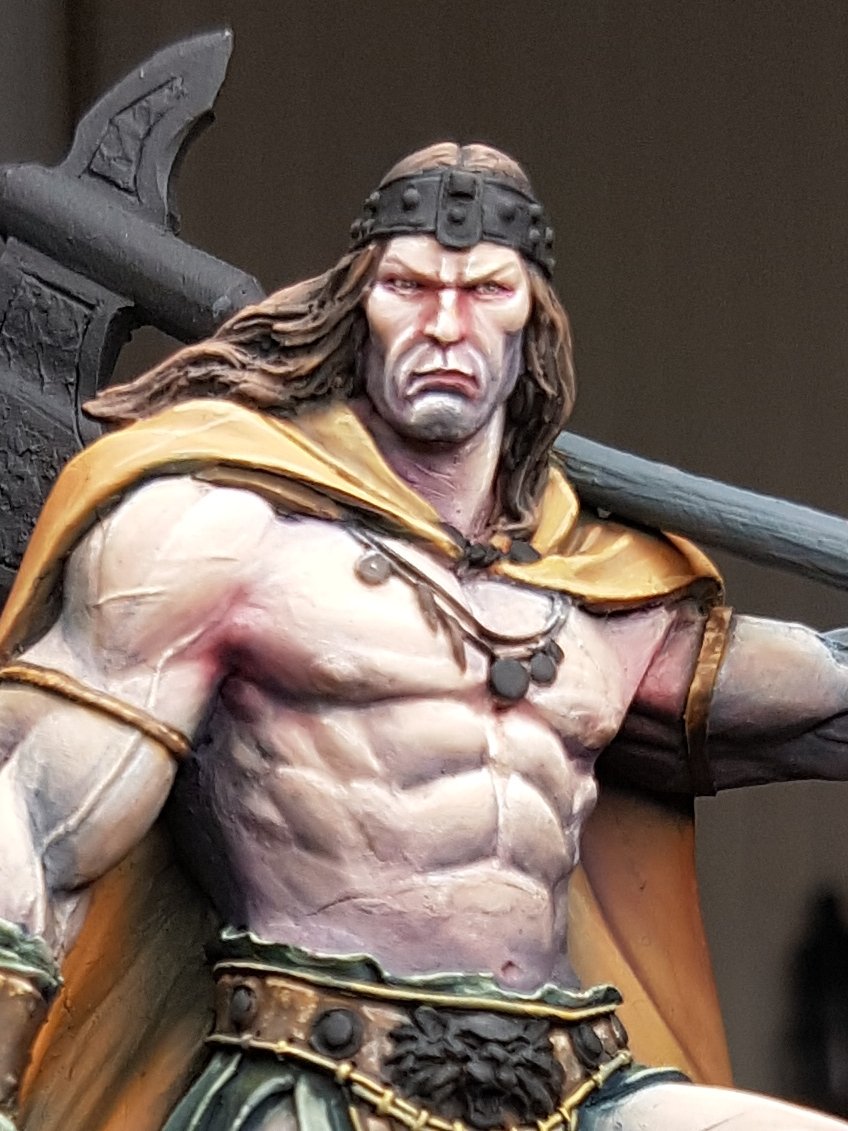I basically just buy models all the time, that I find inspiring. Sometimes, unfortunately, they sit on my shelf, I lose interest in them for whatever reason, or aesthetically I've found something similar that I enjoy more. Occasionally I buy a model and when it arrives I dislike the sculpt. But usually when I buy a model and it turns up, I get super excited, put it on my shelf of models to paint. That shelf has dwindled dramatically the last few weeks! I am running out of cool shit to paint.
Sometimes I forget models that sit on my shelf of models to paint. This was the case with my Conan model, or its proper name: the Barbarian King from Joaquin Palacios Studios. Alongside Lucas Pina, Freeman is probably my favourite sculptor at the moment. He is incredible.
I was showing off my models to Yianni and he was checking out my pile and he pulled that out and had a closer look. I remembered I had it and decided to put it together while I was watching Toya paint some Arcadia Quest models. Once I got it together, it reminded me of old school pieces of artwork from like Frank Frazetta and Boris Vallejo, guys whose artwork made my eyes boggle when I was a young lad. I have been aiming to push myself more and try more difficult techniques on each piece, and this model felt like a good chance to try painting something that was in a similar vein to their artwork: vivid, full of colour and depth and atmosphere.
Cue, crazy balls deep starting point:
I airbrushed some really basic colours and shades onto the model, all very desaturated. The plan was to use wet in wet technique to create some colour and interesting volumes. I added some drying retarder and mixing medium to the colours so that I could spend a bit more time blending and fusing the colours all together. After I mucked around with that, I then used a hairdryer to dry it off, and use some more fleshtone to paint on some highlights.
You can see I have already got a lot of volumes in there with the blending and highlights, as well as a few different colours and tones. One of my techniques that I wrote my article on is called airbrush glazing, so after this crazy wild beginning, I tone everything back down. But because it drops contrast, what you see here is not enough contrast. I pulled out a pure white and cream colour and added even more crazy light points.
One of my mantras these days is "There is no mistakes, only happy accidents". Thanks Bob. But really, when you actually start to live and breathe this mantra, you find yourself with more freedom and creativity. You can always, always fix a bit of paint in the wrong area, or a colour choice not quite right, or a textural mistake or whatever, so why not go crazy and push things and see how it all comes together.
Using my airbrush, I glazed multiple thin coats of mid tone paint over the entirety of the model, softening the transitions and colours and harmonising it all. This is a technique I am using more and more, just in the early stages of my pieces, because I can go crazy large on highlights, knowing that it will be softened.
And this is what it looks like after I use my glazes. You can see the huge difference between the two models, and what is probably most interesting is that to get to that second stage took me all of about five minutes? In fact, this entire process was less than an hour, because I am not worrying about precision and refinement, just actually getting value and tones where I want them.
After this I need to bring more contrast back in, and add a few more colours and tonal interests. Red on the knees, elbows, nose and armpits is usually where I start, and then some cooler blues and purples in the deep recesses. The next step then is to paint in the rest of the model. It is so crucial to have the rest of the colours at least blocked in, because the contrast and relative value of everything relies on everything else surrounding it. The best example of this is when you paint a models base black. Going from either white, or grey and then suddenly having the base black makes the model pop more, because the other areas are not reflecting more light, or are not a higher or similar value. So I pulled out my trusty Panzer Putty, covered the skin and then painted the cloak.
Why orange? I dunno. I've been using so many primaries recently, I wanted to dive into a model with mostly secondary colours. In fact, that was my focus on Alice as well, and she came together so well that I figured I could keep trying to push it and see how far I could take it. The orange I planned to be like a dry leather, with a bit of texture on there.
I pulled off the Panzer, painted the loin cloth in blue, the complementary colour for orange, but kept it very dark. Painted the hair, and suddenly the model looked a lot more accurate to what I was going to be ending up with.
Another thing that the pros do which I've been trying to use more and more is shade and highlight with complementary colours. It adds more richness and diversity to the piece, so I started with blue and purple/red to shade the cloak with. I was pretty heavy handed early on, even though the airbrush creates that really nice effect, adding some actual texture is a part of the plan down the track. I painted in some of the browns and leather areas. Starting to come alive now, as each area starts breaking apart the model.
I went back in and worked a bit more on the skin, smoothing the face details and so on. I kept trying to get the balance right between skin texture, smoothness, colour and contrast. It is still not where I want it, but you can see it is getting close. I also mixed in the orange from the cloak, and some ivory, into the blue of the loincloth. This create a really interesting desaturated green, which I used. It still has some of the hints of blue so I think still works with the orange.
More highlights on the cloak, painting the fur with some more wet in wet work, the leather strappings, painting the leather belt, and getting the skin smoother again, as well as adding more contrast to the lower areas. Looking at the black and white photos I could see that I need more contrast within the skin itself.
I have a large up version of the back of the cloak. I've got a lot of different shades in there, but the highlights are consistent orange, to an ochrey yellow. The next stage of their highlights will be a cream colour which should make the cloak pop off the model.
I also painted the eyes, a very difficult job on this model as they are inset, and very small. I managed to nail it first time, which I am stoked about. I also added some blue tones to the lower jaw, and a bit more white to his forehead and nose.
Moving forward from here, I want to use some really small micro stippling to add to the stubble effect on his jaw, to put even more redness into the nose underneath, work on the hair more so it is more refined, add those pop highlights and texture scratches on the cloak, smooth the torso skin tones out just a tiny bit more, darken up the leathers on the lower half of the model and make the fur even darker, make the straps and cables around the belt ivory, paint the wooden haft and then move into the metallics!
I've still got the base to consider, which I've been waiting on some more plinths before I put together, but I am really excited to play around with one, because I feel its an area that I need work on, but also one that I have started to develop.
Exciting times.












No comments:
Post a Comment